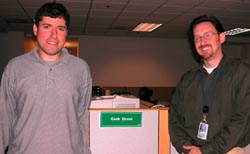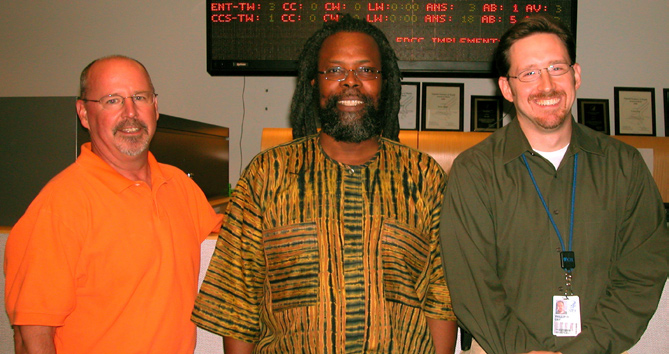| |
 |
|
|
|
|
| |
Frontline agent Alex Naron (l) with Phil Day, NIH Help Desk branch chief |
|
And it’s a blast. No, really. Overviews by Day and his team are on point, while customer satisfaction
metrics show a lot of transparency. Most survey responses are glowing—“I made a silly error...[the tech] gets extra points for not calling me a bonehead”—but you can also see the occasional gripe: “Sometimes the employees seem bored.”
The coolest moments come when you shadow the techs and listen in.
We’ve all been there. We’ve had our frontline problems (“I typed my password backwards”); connectivity issues (“My BlackBerry’s gone berserk”);
and queries on Enterprise systems like NBS Travel. Then there are outages and maintenance,
tracked by the “HotNews” folks working 24/7 in the Continuity Assurance Program.
Now we’re behind the curtain, to watch a creative
response to overarching change.
First, in 2003 came the Department of Health and Human Services’ mandate that all NIH institute and center (IC) help desks form a single
structure as first point of contact; meanwhile,
each individual IC would retain and manage
its own local desktop staff.
“Our challenge here,” says Frontline Manager Chuck Krzywicki, “is to recognize that there may be 27 different ways of handling the same issue.”
 |
Frontline Manager Chuck Krzywicki (l) is joined by section chief Tony Roberts (c) and NIH Help Desk branch chief Day.
Photos: Belle Waring |
For example, the consolidated CIT Help Desk (CIT-HD) does offer Mac support, if the ICs allow Macs.
The second major shift came when most CIT offices moved from Bldg. 12 to Fernwood. While the off-campus billet has its plusses, it’s minus certain reminders of the NIH mission: researchers
huddled over lunch, migratory interns and indigenous Help Desk “locals.”
CIT-HD frontline agents are an entry-level cohort and tend to be on the young side. How, at this remove, Day wondered, were they ever going to “get” NIH?
“We were buried in the weeds so much,” he says. “We needed a fresh mind. So we thought, hey, why not have an exchange with local techs? If you meet with someone one-on-one, you start to resolve the conflicts borne of a lack of understanding.”
A class was born. Conceived for IC techs, it welcomes non-geeks. “We get a lot of good ideas from other techs across NIH,” says Day, “as well as from users.”
“And an important part of the story,” Krzywicki stresses, “is where we are going.”
The class previews a new industry standard for best practices, the IT Infrastructure Library (ITIL), scheduled for a fall launch at the Help Desk.
ITIL offers a change of name—from “Help Desk” to “Service Desk”—and a new paradigm.
Currently, CIT-HD creates the ticket, solves what it can and then, if appropriate, triages either to the ICs (where how they handle it is up to them) or to the service provider.
After dispatch, the Help Desk doesn’t currently track outcomes. “But the Service Desk will follow up with customers to see if they’re happy,” Day explains.
Plus, even if his own team “turfs” the ticket to the ICs, CIT-HD will get “feedback from the IC, information
about applications,” he says. “The concept is that the ticket is closed when the customer says it’s closed. That’s new.”
The Service Desk will partner with ICs as advocate for the user. Until then, the class can provide insight:
- CIT-HD’s central work area shows digital assignment
boards tracking the status of all calls—like airline flight monitors, without the cancellations. Designed to absorb noise that arises from open seating, the space is busy, but calm; you can hear yourself think. “A lot of folks are teleworking and desk-sharing,” says Day, “but they do have to be here a minimum of 2 days a week.”
- If you have an urgent problem, says Day, call it in: “By having direct contact, the Help Desk agent is able to engage and ask the appropriate questions faster. Kind of like when dialing 911.” Otherwise, the online request form at http://ithelpdesk.nih.gov/ is preferred for routine requests; the form creates
a ticket, saving a step.
- Who calls the Help Desk? 45,000+ customers at NIH. Extramural grantees. The general public. “Anybody,”
says Day. “We help people around the world with NIH videocasts. They call and say, ‘My RealPlayer
doesn’t work.’”
- Quote of the Day: “Which is more important: technical skills or customer service skills? If you don’t have empathy for the customer, you’re not going anywhere.”
